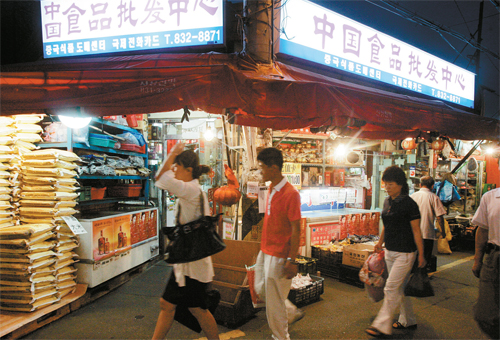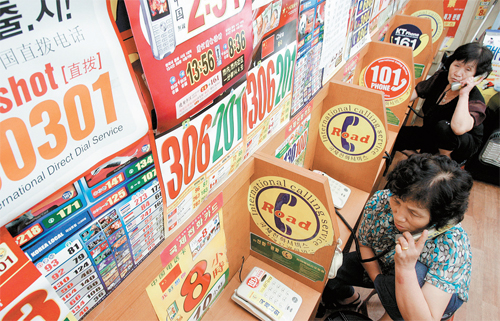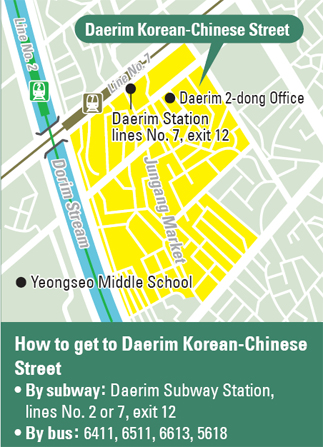Chinese market for ethnic Koreans

Many of the signs along Daerim Korean-Chinese Street, Seoul’s largest Korean-Chinese residential area, are written in Chinese. By Jeon Min-kyu
Only five - Itaewon-Hannam, Yeoksam, Ichon, Yeonnam and Seorae Village - have been designated as global villages, making expats there eligible for administrative, language and counseling support from the city. But many other Seoul areas are emerging as zones heavily frequented by foreign nationals.
To reflect these demographics, the city government has experimented with what it calls multicultural village centers similar in concept to the global village centers. The first multicultural village center was established for Korean-Chinese people, the biggest expat community in the city. These are ethnic Koreans from China.
Daerim Multicultural Village Center opened last month in Daerim-dong, Yeongdeungpo District, southwestern Seoul, the biggest residential area for Korean-Chinese immigrants.
“Over the recent years, Daerim-dong has become the place where most Korean-Chinese people choose to settle,” said Lim Gwang-sun, a Seoul city official. “It is now an important area requiring our care.”
A decade earlier, most joseonjok, the term in Korean for Korean-Chinese people, gravitated toward the Garibong-dong area, bordering Daerim-dong, but a string of redevelopment projects have forced many out. Some went to Ansan, a Gyeonggi city south of Seoul, while others spilled over into Daerim-dong.
According to the Daerim-dong Office, around 46 to 47 percent of the people in Daerim 3-dong are Korean-Chinese. Yeongdeungpo District Office said that there were 36,855 expats living in the district as of July, of whom 33,573, or more than 90 percent, are Korean-Chinese. Another 1,103 people were Chinese.
Daerim Korean-Chinese Street at Jungang Market in Daerim 2-dong reflects the fast growth of the Korean-Chinese community.
Many first-time visitors to the scores of shops around the outdoor market might well think they have landed in China. Many of the signs are written in Chinese and people in the neighborhood speak a variety of Chinese languages. Even though they are ethnically Korean, the residents here grew up in a different culture and are used to a cuisine that Koreans who grew up in South Korea consider exotic. The names of several restaurants here end with banjeom, which Koreans think means Chinese restaurant in Chinese.
But, if you order jjajangmyeon, Chinese noodles in black bean sauce, there as you would in local banjeom, you might get an odd look from the restaurant owners. At Seonghae Banjeom, one of the eateries there, jjajangmyeon isn’t on the menu of over 100 dishes.
“Jjajangmyeon is not that popular among Chinese people,” said a young female worker at the banjeom, who identified herself as Korean-Chinese with the first name Su-jin.
“We serve jjajangmyeon, but it’s not the one most Koreans have tried.”

Two Korean-Chinese women speak on the phone to relatives in China in a makeshift international telephone booth in front of a supermarket at Daerim Korean-Chinese Street, last Saturday. This is a common sight at the Korean-Chinese heavy area in Yeongdeungpo District, southwestern Seoul. By Jeon Min-kyu
Most of the other dishes cost between 8,000 won and 35,000 won, expensive even by Korean standards. “Eating is important to Chinese,” Su-jin explained.
There were also several street vendors selling food at the market.
A sign outside a butcher’s shop owned by Lee Chung-lee, 53, said in Chinese “Wenzhou Restaurant,” referring to a city in Zhejiang Province, southeast China, known for its cuisine.
“Korean-Chinese people come to us to eat meals they used to have at home in China,” said Lee. “Not much of the food we sell here would appeal to Koreans because of the strong Chinese spices used in them,” she said.
Locals also don’t eat some of the dishes popular among Korean-Chinese diners. One customer dropped by Lee’s place to pick up pig’s ears. “Pig ears are a delicacy favored by the Chinese,” she explained.

Chinese is an “official” language on Daerim Korean-Chinese Street, where many signs outside shops are written in Chinese and residents speak more Chinese than Korean. By Jeon Min-kyu
For her first four years here, she did menial work in construction, homes and restaurants. With the money she saved, she started a butcher’s shop a year ago, which she called a “dream come true.” “For many Korean-Chinese people, opening their own shop in Korea is a lifelong goal, one of the reasons they came to this country,” said Lee.
According to the Ministry of Public Administration and Security, the number of foreigners living in Korea as of May 1 was more than 1 million, of whom 56 percent were Chinese nationals, including Korean-Chinese people.
Owners of small businesses like to hire from this pool because they are bilingual, and many end up doing jobs that are dirty, dangerous and difficult - the 3Ds - which Koreans increasingly avoid. According to Kim Hee-jin, 74, president of an association of Korean-Chinese people in Daerim-dong, thousands of Korean-Chinese come to Daerim-dong every year looking for factory jobs.
“Korean-Chinese people make a significant contribution to the Korean economy,” Kim said, adding that could be an even more valuable resource for Korea in one or two decades when, he said, China will become the world’s largest economy.

“We’ve heard the government might designate Daerim-dong as a special area for Korean-Chinese people,” he said. “If this is true, it will let Korean-Chinese people settle in Korea more easily and would, I think, help us contribute more.”
By Moon Gwang-lip [joe@joongang.co.kr]










with the Korea JoongAng Daily
To write comments, please log in to one of the accounts.
Standards Board Policy (0/250자)